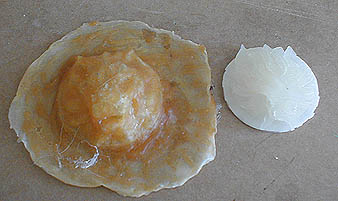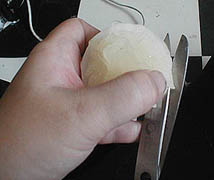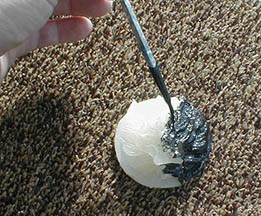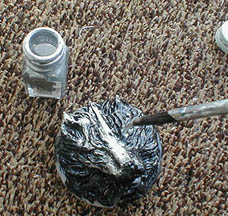

Home / Sculpting / Making a Mold / Casting / Painting / Gem Making Tutorial / Links / Contact Me

After you've removed the object you're molding from the latex you may find the resin has overflowed a little. You can clip off the excess with a heavy scissors. (The resin should still be soft enough for you to do so.) Examine the cast object closely. If you find that the latex has failed to fill a certain area, you can build it up using hotglue. (You can also thicken the object by squeezing out a layer of hotglue over the back of it.) Wait another full day for the resin to harden fully before you paint it.


I'd recommend using enamel paints for resin (acrylics are more likely to flake off.) For the wolf ornament, I used a special painting technique called antiquing, which is to paint an object in such a way that it looks weathered and ancient, with silver covering the raised areas of the object and black paint filling the lines and surface crevasses.
Antiquing with enamel is a bit tricky. (With acrylic paint, you can lay down the silver first and wipe on thinned black pigment with a cloth, but that won't work with most enamels: the cloth will just stick to the surface.) So the first thing you must do is brush on a layer of black (glossy or matte paint, whatever you prefer. I don't think it makes much of a difference.)

Wait a few hours for the black layer to dry. Then lightly drybrush silver enamel over the top of the object, taking care not to fill in the lines and crevasses. (OR, you can gild the surface of the object with silver leaf sheets or rub Rub 'n' Buff Wax Metallic Finish Paste over the surface of the object). Experiment with different paints and finishes until you come up with a look you like.

The last step in making my wolf ornament was to paint the plastic ring (which I earlier cut to fit into the mouth) and glue it into place. I can now either glue the ornament to another object or glue some sort of fastener to the back of it. (Make sure that, when you attach any sort of fastener or pinbacking to your object, that you use a nice strong glue, like E-6000. (Hotglue will most likely NOT be strong enough.)
There you have it - a quick and dirty guide for casting solid, painted resin objects. (But AA, you ask, what if I want to make a clear resin gemstone? What if I want to make that gemstone a certain color?)
Wanna know the answer? Then click to read AA's Quick 'n' Dirty Guide to Making Resin Gemstones...
